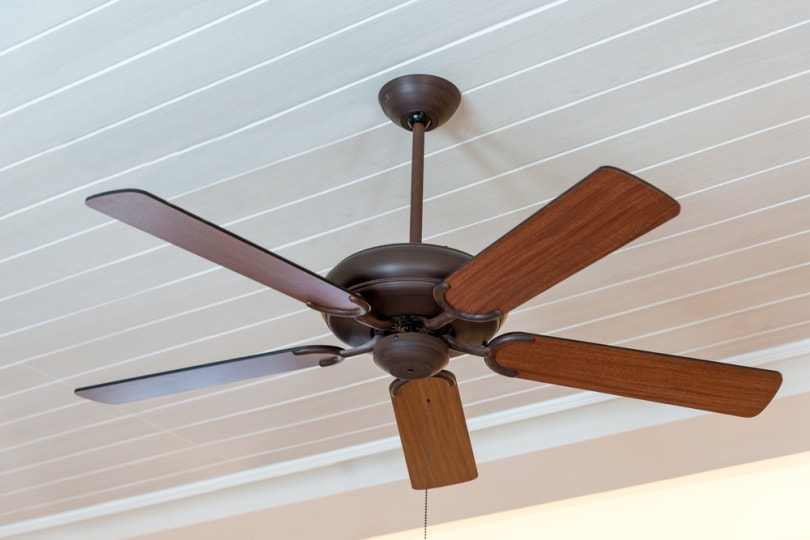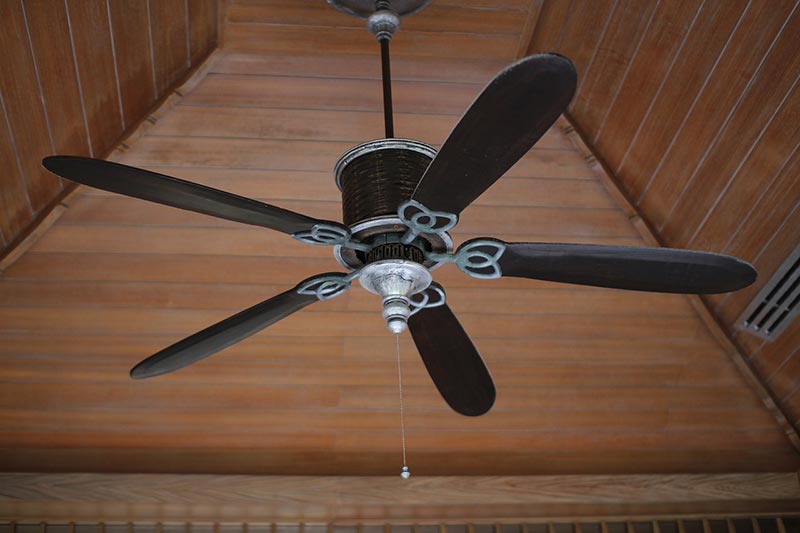How Much Electricity Does a Ceiling Fan Use? Facts & FAQ
-
Codee Chessher
- Last updated:

Ceiling fans are an attractive and practical way to cool rooms without using tons of power, but most people probably can’t pinpoint how much power they use. Ceiling fans today range between 30–100 watts, but most are somewhere in the middle. Smaller fans with fewer or smaller blades will naturally use less power, while larger fans with more blades will use more.
How do those 30–100-watt numbers translate into power costs? First, we’ll need to do some basic calculations. A 50-watt ceiling fan will use 1.2 kWh, or kilowatt-hours, per day. The cost of power varies widely around the nation, but national averages are around $0.13 per kWh of power used. Let’s use that to estimate how much it costs to run your ceiling fan for 4 hours a day.
The cost per hour would be tiny, around $0.0060, or just over half a penny. But what about a day, week, month, or year? Let’s find out below.
- A day: $0.02
- A week: $0.10
- A month: $0.73
- A year: $8.76
As you can see by those numbers, running your ceiling fan is extremely energy efficient and barely makes a dent in your annual electricity costs. If you use it more, though, those numbers will go up. However, even running it 24/7 for a year would only cost around $52.
Energy Usage of Ceiling Fans vs. Other Fans and Appliances
You’re no doubt wondering if ceiling fans are really that efficient. To find out, we’ll have to compare them to the average electricity usage of other fans and appliances in your home. Below, we highlight the annual energy usage of some other common fans and appliances.
| Appliance | Annual Costs |
| Pedestal Fan | $10.51 (4 hours of use per day) |
| Box Fan | $12.79 (4 hours of use per day) |
| Window Air Conditioner | $122 (4 hours of use per day) |
| Central Air Conditioner | $613 (4 hours of use per day) |
| Refrigerator | $189 (24/7) |
| Coffee Maker | $11.56 (0.3 hours of use per day) |

What Is CFM and How Does It Impact Fan Efficiency?
CFM means cubic feet per minute and describes how much air a fan can move per minute. In practical terms, it means how much cooler the fan can make you. Fans with high CFM and low wattage are considered energy efficient, while fans with low CFM and high wattage are less efficient.
CFM is determined by three factors: motor power, blade pitch, and the length, shape, and material of the blades. How motor power is related is pretty obvious, so where do the blades come in? It is complex, but generally longer fan blades will move more air. Other innovations like oscillation can also increase CFM.
CFM is a useful measurement to estimate how big an area a fan will cool. Higher CFMs are great for large rooms or spaces, while lower CFM fans are best used in small rooms.
Fans today have an average CFM of 4,000, which includes small table fans, medium-sized box fans, and ceiling fans alike. Higher-end fans can move up to 10,000 CFM. However, each type has a different average CFM. Let’s check those out and see which fans are the most efficient.
| Fan Type | CFM |
| Box Fan | 1,000–2,400 |
| Pedestal Fan | 2,500–10,000 |
| Ceiling Fan | 4,000–10,000 |
| Table Fan | 2,000–9,000 |
Ceiling fans are overall more efficient in terms of CFM to wattage, but all types of fans are pretty cheap to run.
How to Save Electricity With Your Ceiling Fan
Ceiling fans are very energy efficient already, and there aren’t many ways to cut corners on their meager energy needs. The best way you can save electricity is to buy an EnergyStar-rated ceiling fan, which ensures it uses less power than comparable models.
Other than that, you should be turning off your ceiling fan when you’re not in the room. Fans only cool the people in the room and do nothing to cool the ambient air, so keeping them on while you’re out is a waste of power.
Conclusion
Ceiling fans are a great way to cool a room without sacrificing floor space, and they’re generally better at moving air too. Installing an EnergyStar-rated ceiling fan can save you money in the long run, just like turning the fan off when you leave the room.
Featured Image Credit: Supermop, Shutterstock
Contents


